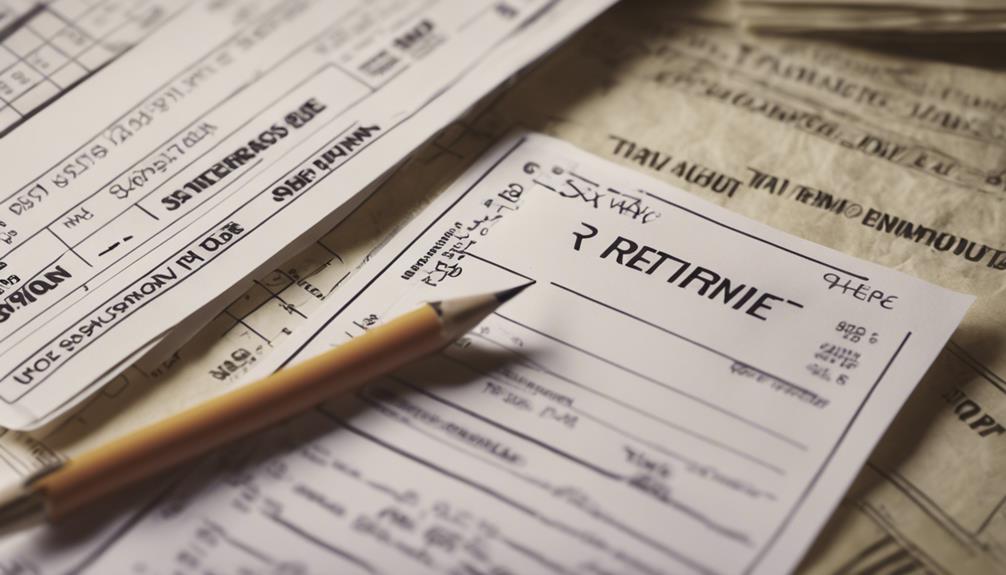When withdrawing your retirement savings, consider meeting qualifications based on financial hardship, low income, medical expenses, and more. The Pension Benefits Act outlines specific guidelines to adhere to. Keep in mind that financial institutions may not verify all of your information. Your withdrawal options are determined by your age, residency, and the type of retirement plan you have. Understanding the application process and requirements is essential for making informed decisions. Additionally, be mindful of the impact of withholding taxes, potential fees that may be deducted, and the loss of protection from creditors. These factors will influence the decisions you make regarding your financial future.
Key Takeaways
- Understand eligibility criteria for financial hardship withdrawals.
- Be aware of withholding tax percentages on withdrawn funds.
- Consider financial institution fees and withdrawal charges.
- Note the loss of creditor protection upon accessing retirement funds.
- Rebalance portfolio for growth potential after cashing out retirement plan.
Eligibility for Fund Withdrawal
When determining eligibility for withdrawing retirement funds, various criteria such as financial hardship, low income, high medical/disability costs, non-residency, or shortened life expectancy play an important role. Under the Pension Benefits Act, specific eligibility criteria must be met to access retirement funds.
To access these funds, individuals need to meet the outlined conditions and submit applications that adhere to the requirements set forth by the Act. Financial institutions processing these applications aren't mandated to verify client figures, making the responsibility of meeting the criteria solely on the applicants.
The access options available for individuals may vary depending on factors like age, residency status, and the type of retirement savings plan they hold. Understanding the application requirements and eligibility criteria is vital for those looking to access their retirement funds due to financial hardship, low income, high medical/disability costs, non-residency, or shortened life expectancy.
Types of Financial Hardship Criteria

To access retirement funds due to financial hardship, individuals must meet specific types of criteria, including medical expenses, arrears of rent or debt secured on a principal residence, first and last month's rent, and low expected income. Opening up for financial hardship can be done for a combination of reasons, providing flexibility.
The Pension Benefits Act allows one application per calendar year, per account, in each financial hardship category. However, multiple applications are accepted for medical expenses when several individuals are affected by illness or physical disability.
It's crucial to remember that separate FSRA forms must be completed for each specific financial hardship category when applying to release retirement funds. This ensures that the process is streamlined and that all necessary information is provided accordingly.
Impact of Withholding Tax
After meeting the specific criteria for financial hardship and applying to release retirement funds, individuals encounter the impact of withholding tax on their withdrawn funds from locked-in retirement accounts. When funds are withdrawn, financial institutions withhold a percentage for federal income tax. This withholding tax amount can vary based on the specific account and the withdrawal amount.
Additionally, financial institutions may impose withdrawal fees on accessible retirement funds. Both taxes and fees are deducted before the remaining funds are disbursed to the individual. It's crucial to be aware of these factors when considering cashing out your retirement funds, as they can greatly impact the final amount you receive.
Understanding the implications of tax withholding and potential fees can help individuals make informed decisions about accessing their locked-in retirement accounts. Remember to factor in these deductions when planning for your financial future.
Consideration of Financial Institution Fees

When withdrawing retirement funds, it's important to take into account the potential fees imposed by financial institutions, such as withdrawal charges and account closure fees. These fees can vary depending on the type of account you hold and may impact the amount you receive after withdrawal.
Before cashing out your retirement funds, it's advisable to compare these fees across different financial institutions to make an informed decision.
Understanding Withdrawal Charges
Financial institutions may impose withdrawal charges on retirement funds, which can include withholding a percentage for federal income tax and specific fees depending on the account type. These withdrawal fees and tax withholdings are deducted before the disbursal of funds to the individual.
The exact amount withheld and the fees charged vary among specific financial institutions. It's important to be aware that once funds are withdrawn, they lose their creditor protection as outlined in the Pension Benefits Act.
Understanding the implications of these charges and taxes is vital when considering cashing out your retirement plan. Be sure to inquire about the withdrawal fees and tax implications with your financial institution to make informed decisions about accessing your retirement funds.
Comparing Account Closure Fees
Comparing account closure fees among different financial institutions is essential for maximizing the value of your retirement funds when withdrawing. These fees can vary significantly and directly impact the amount you ultimately receive.
Before cashing out your plan, it's important to understand how these financial institutions charge for closing your account. By comparing account closure fees, you can make more informed decisions about accessing your retirement funds.
Remember, these fees are subtracted from your total withdrawal, so being aware of the costs associated with each institution is key to optimizing your funds.
Stay informed about the financial implications of account closure fees to make sure you get the most out of your retirement savings.
Loss of Creditor Protection

Upon accessing funds from locked-in retirement accounts, individuals lose the creditor protection provided by the Pension Benefits Act. This means that once the funds are in hand, they are no longer shielded from creditors. Whether the withdrawal is due to financial hardship access or for other purposes, the loss of protection applies universally. Here is a table to illustrate this loss of protection:
| Before Withdrawal | After Withdrawal |
|---|---|
| Funds are protected | Funds are vulnerable |
| Creditor protection intact | Creditor protection lost |
| Secure from creditors | Exposed to creditors |
It's essential to contemplate the implications of this loss when deciding to access funds from a locked-in retirement account. Once accessed, the funds no longer benefit from the guaranteed protection previously provided. Make informed decisions about your finances to safeguard your assets effectively.
Application Process for Fund Unlocking

After understanding the implications of losing creditor protection upon accessing funds from locked-in retirement accounts, the next step is to navigate the application process for releasing your retirement funds.
The process involves submitting specific FSRA forms to your financial institution. Each financial hardship category allows for one application per calendar year, per account. However, for medical expenses, multiple applications are permitted for individuals suffering from an illness or disability.
Remember, separate FSRA forms are required for each financial hardship category you're applying under. To start the accessing process, make sure you have all the necessary forms, which can be found on the FSRA website. Make sure to take into account the tax implications and how this withdrawal fits into your financial plan.
Managing Invested Funds After Withdrawal

After withdrawing funds from your retirement account, it's vital to contemplate reinvesting to maintain savings growth. Reviewing investment options for a balanced portfolio post-withdrawal is imperative.
Monitor market trends and seek advice from a financial advisor to navigate managing your invested funds effectively.
Post-Withdrawal Investment Strategies
Considering our risk tolerance and financial goals, we're advised to reinvest withdrawn funds in a diversified portfolio to maintain growth even after withdrawal.
It's essential to assess our post-withdrawal investment options carefully. Seeking professional advice on reinvesting strategies tailored to our financial goals can help optimize returns.
Monitoring market trends allows us to make informed decisions and adapt our portfolio as needed. By staying informed and proactive, we can guarantee that our investments align with our evolving circumstances.
Remember to regularly reassess your retirement plan to stay on track towards your financial objectives. Balancing risk and growth is key to achieving long-term investment success.
Rebalancing Portfolio for Growth
To maximize growth potential post-withdrawal, we should consider evaluating our portfolio towards more growth-oriented investments. After analyzing risk tolerance and time horizon, reallocating funds into areas with higher growth potential can help recover withdrawn amounts.
Diversifying the portfolio across various asset classes can spread risk and capture opportunities for growth. It's crucial to monitor and adjust the portfolio regularly to align with changing financial goals.
Seeking guidance from a financial advisor can assist in developing a tailored investment strategy post-withdrawal. By staying proactive and strategic in our investment decisions, we can work towards optimizing our portfolio for growth and long-term financial success.
Tax Implications and Planning
How do withdrawn funds from retirement accounts impact our taxable income, and what strategies can we implement for effective tax planning after withdrawal? Withdrawn funds are subject to income taxes and may incur early withdrawal penalties based on tax rules. Financial institutions withhold a portion for federal income tax, and withdrawal fees might apply. Before disbursal, taxes and fees are deducted, affecting the final amount received. It's important to take into account the loss of creditor protection once funds are withdrawn. To manage tax implications, individuals should plan ahead, consult with financial advisors, and explore tax-efficient investment options. Below is a table summarizing key points for effective tax planning post-withdrawal:
| Key Points | Description |
|---|---|
| Taxable Income | Withdrawn funds increase taxable income |
| Early Withdrawal Penalties | Possible penalties based on tax rules |
| Withholding by Institutions | Financial institutions withhold for taxes |
| Withdrawal Fees | Fees may apply depending on the institution |
| Creditor Protection Loss | Protection decreases after funds are withdrawn |
Frequently Asked Questions
Can a Retirement Plan Be Cashed Out?
Yes, a retirement plan can be cashed out, but it's important to take into account the potential penalties, taxes, and impact on future savings.
The specific options for cashing out vary based on the type of retirement account. Evaluating financial needs, tax implications, and long-term effects is essential before making a decision.
Seeking guidance from a financial advisor can help determine the best approach for cashing out a retirement plan.
How Do I Cash Out My Retirement Savings Plan?
When we cash out our retirement savings plan, we must remember the specific criteria outlined by the Pension Benefits Act. Submitting the required FSRA form to our financial institution and understanding the implications of potential taxes, fees, and loss of creditor protection on the withdrawn funds are vital steps.
Please be aware that funds withdrawn from locked-in accounts are included in our taxable income for the year by the CRA.
How Can I Withdraw Money From My Locked Retirement Account?
If we want to access funds from our secured retirement account, we need to meet specific releasing conditions set by regulations. Options include financial hardship, low income, high medical/disability costs, non-residency, and shortened life expectancy. Different forms are needed for each option, with no need to verify client figures.
Taxes, fees, and loss of creditor protection may apply. To start the process, we've to submit the appropriate FSRA form to our financial institution.
Can I Close My 401K and Take the Money?
Yes, we can close our 401(k) and take the money, but doing so before age 59.5 incurs penalties and taxes. Early withdrawals trigger a 10% penalty on top of income taxes owed.
Hardship withdrawals may be allowed for specific financial needs like medical expenses or education costs. Considering a 401(k) loan may be a better option to avoid penalties and taxes.
It's important to weigh the financial impact and long-term consequences before cashing out our 401(k).
How Does Cashing Out Your Retirement Plan Affect Your W2?
Cashing out your retirement plan on W2 can impact your tax situation. The amount withdrawn is usually subject to a 10% early withdrawal penalty if you are under 59.5 years old. Additionally, the distribution is considered taxable income, potentially increasing your tax liability for the year.
Conclusion
In summary, withdrawing your retirement funds is a significant decision that requires careful consideration of eligibility criteria, financial hardship, tax implications, fees, and creditor protection.
It's essential to understand the application process and manage your invested funds wisely after withdrawal. Make sure to weigh the pros and cons before accessing your retirement funds to guarantee you're making the best choice for your financial future.











